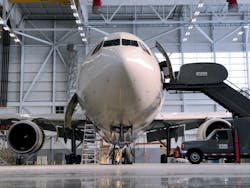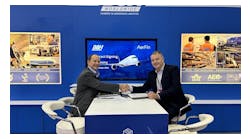MRO Market for Next 10 Years Is “Basically Bullish,” But Challenges Remain
The numbers tell the tale. Oliver Wyman’s Global Fleet & MRO Market Forecast Commentary, 2018 – 2028 contends “These are heydays for the commercial aviation industry as well as businesses supporting it,” the study’s Executive Summary says. Total MRO spending is projected to increase to US$114.7 billion from today’s US$77.4 billion — a full 48 percent predicated on an average 4 percent compound annual growth rate (CAGR).
Heydays indeed, but disruptive nonetheless. The consolidative trend of recent years continues seemingly unabated. Oliver Wyman cites Illinois-based AAR’s move to purchase a pair of Canadian MRO facilities from Premier Aviation as well as China’s HNA Aviation Group’s acquisition of Swiss-headquartered SR Technics. The big are, quite simply, getting bigger. The Executive Summary says, “The trend in MRO is cutting the number of players while simultaneously increasing the scale of those left standing.” Increase not just in scale, but in diversity of product as well. StandardAero CEO Russell Ford says in 2017 his company completed the acquisition of a large engine MRO firm, as well as a pair of powerplant component repair companies. “Since engine MRO companies are often owned by engine OEMs or airlines we don’t see quite as much acquisition opportunity in that area as we do in a more fragmented space like engine component repair and manufacturing."
David Marcontell believes such OEM ascendance is a powerful force to be reckoned with by the MRO industry. The general manager and senior vice president of CAVOK, a division of Oliver Wyman says, “With the exception of line and airframe heavy maintenance, we are truly beginning to imagine in the not too distant future a world dominated by OEMs, much like the automotive industry.” But OEM heft, Marcontell is quick to add, “doesn’t mean that the place for independent MRO has disappeared.”
Indeed not. Tallinn, Estonia headquartered Magnetic MRO is an example of the fact that you don’t necessarily have to be huge to be viable. Magnetic’s operations manager Kaspars Podins says that in the upcoming year, “We will see new aircraft starting to visit MROs more:” Boeing 787s, Airbus A350s, A320neos, and Boeing 737 MAXes. The new breed of geared turbofans is going to be paying visits too. Podins says as these new-generation jets are introduced with their new technologies and vastly improved operating costs, “This will also lead to customer demand for improvements and modifications on older narrowbody aircraft.”
Gregoire Lebigot, president and CEO of Vallair, says, "Current larger operators are now booking greater capacity further in advance. RFQs for slots dating through to 2019 and beyond are becoming routine rather than the exception. Ultimately, this is putting greater pressure on the smaller operators, who may not have the ability of their larger competitors to reserve such capacity so far in advance."
Boeing’s play to capture more of the aftermarket, with a goal of $US50 billion, is illustrative of what’s going on here. Oliver Wyman research indicates that OEMs servicing engines handle some 53 percent of the powerplant market. Airlines and their affiliated MRO operations control 64 percent of the airframe and maintenance market and OEMs a hefty 58 percent of the component aftermarket.
Propelling growth is the burgeoning global fleet. Oliver Wyman believes by 2028 the worldwide array of commercial aircraft will increase to 37,978. That’s compared to the present tally of 26,307. “Narrow-body aircraft will be the biggest beneficiary of this expansion, increasing from about 56 percent of the fleet in 2018 to 66 percent in 2028.” Illustrating the kind of fleet culling that we can expect, by 2028 jet aircraft built in the 1990s will comprise 41 percent of the total global fleet. Today it’s two-thirds.
Hot Spots
MRO usually follows fleet growth, and over the ensuing 10 years that means China is the epicenter of closely watched planes. The Oliver Wyman study projects that by 2028 the growth rate of China’s expansive fleet of commercial jet aircraft will be a full 8.8 percent. By way of comparison, the North American fleet is projected to be a mere 1.5 percent, and the worldwide fleet 3.7 percent.
By 2028 MRO spend in the People’s Republic should reach US$17.8 billion. For 2018 the figure is US$6.5 billion. That’s a 10.6 percent growth rate. By contrast, MRO spend in Western Europe in 2018 is forecast to be a hefty US$16.2 billion. By 2028 the figure should be US$21.7 billion, with a growth rate of 3 percent — one-third that of China’s.
“In … Asia, the biggest MRO market and with the strongest growth predicted, several national initiatives are trying to create new MRO clusters,” says Norbert Marx, CEO of Guangzhou Aircraft Maintenance Engineering Company Ltd. (GAMECO). “China will proceed with large scale integration of networks and subsequent industrialization, creating some strong contenders to today’s industry leaders.”
MTU Maintenance senior vice president of MRO programs, Leo Koppers says, “We will further invest in our Chinese facility. Its capacity of 300 shop visits per year is to be expanded in capacity by another 50 percent again within coming years so as to keep up with local market growth as well as to accommodate any new programs.”
New programs, added capacity, new acquisitions. All of this affects MRO spend. For comparison’s sake, here’s Oliver Wyman’s geographic rundown of projected MRO spend in 2028:
Africa – US$3.4 billion
Asia Pacific – US$20.9 billion
China – US$17.8 billion
Eastern Europe – US$4.3 billion
India – US$3.2 billion
Latin America – US$6.2 billion
Middle East – US$13.5 billion
Western Europe – US$21.7 billion
Add all this up and the aggregate worldwide expenditure on maintenance, repair and overhaul in 2028 is US$114.7 according to Oliver Wyman’s projections. This compares with 2018’s forecast of US$77.4 billion.
Clear Air Turbulence
In the never-ending quest to cut operating costs the study says “unexpected problems” can arise. The newer crop of aircraft, particularly the 787 and A350, not only have long legs, they possess commensurately longer airframe maintenance intervals. That extends the time between scheduled downtime. Here’s the problem: traditional check intervals used to offer airlines a pre-arranged time slot to refurbish interiors. The new timetables ‘twist checks “no longer afford timely opportunities for cabin repairs,” concludes the Executive Summary.
There’s also an impediment to universal adoption of an array of additive manufacturing tools. The Oliver Wyman study says, “The cost of equipment and OEMs' reluctance to share proprietary designs make it difficult for the MRO industry to adopt 3-D printing for spare parts or for the aftermarket to derive any real tangible benefit from the new technology.”
But the greatest gremlin lurking out there is one MROs have been grappling with for years now: a paucity of trained technicians. The generation gap plays a real role here. Baby boomers, those who possess the technological know-how to work on old as well as newer aircraft are retiring, and millennials are loathe to pursue a career in aviation maintenance. In the United States the report cautions of a shortfall by 2022, with a 9 percent gap projected between the supply of aircraft technicians and the demand for them by 2027. “This shortage could produce problems for the aviation industry just as the fleet is expanding and technologically sophisticated aircraft are being incorporated.”
The industry is addressing the problem by increasing wages and emphasizing training. “We’re working hard. All of us are,” says Paul Dolan, COO of Aviation Technical Services. The aim is “to attract new technicians to the industry and promote the field as an attractive long-term career option.” That entails paying competitive wages, “robust training” with local schools.
AAR’s vice president of MRO Services, Troy Jonas, echoes Dolan’s sentiments. “There’s been a shortfall of high-quality technical jobs like AMTs (aircraft maintenance technicians) since [U.S.] government education policy and funding moved away from technical schools/training and to four-year colleges.” Like others, AAR “has done our best” to partner with community colleges and tech schools near its seven U.S. facilities.
“People, people, people,” laments Richard Kendall, CEO of HAECO Americas. It’s the dominating issue of our times when it comes not just to qualified technicians but pilots as well. Both are in strong demand and short supply. How to get the numbers needed without sacrificing quality is critical. Kendall believes “advances in technology will help, [but that] MRO will remain a very labor-intensive industry for the foreseeable future.” HAECO Americas spent the last year updating processes and implementing technology to better equip its technicians. Kendall says the MRO is also “reviewing employee engagement and retention best practices to secure stability within our workforce.”
The High Tech Imperative
Change may be good, but it can also be a pain. CAVOK’s Marcontell asserts, “MRO industry leaders are going to have to figure out their technology roadmap and how to fund, develop, and manage large-scale change and technology implementation projects.” Here comes the pain part: they’re going to have to do so “at a pace they have never experienced before.” This is going to require a completely new set of skills that most organizations are struggling to find.” MROs are going to have to deploy those skills on top of outdated MRO information technology, and do it in a highly regulated environment that manifestly is not accustomed to rapid change.
GAMECO’s Marx says, “Linking numerous data sources from the aircraft, airline, logistics, suppliers, and MRO into a smart maintenance solution is recognized by many as the way to go and is in different stages of realization.”
There’s a price to be paid in digitizing MRO, one in treasure the other in shedding old ways of thinking. David Doyle, vice president of business development, innovation management and product development at Lufthansa Technik, says, “We’re preparing ourselves for a major transformation of the MRO industry.” The reasons behind preparations are “well documented: digitization of the airline/MRO interface, artificial intelligence, new technologies, and consolidation of OEMs.”
Sophisticated technology is evident in an increasing array of MRO arenas. AFI KLM E&M is a good case-in-point. The MRO’s head of strategy, Vincent Metz, says virtual reality (VR) is beginning to play a significant role in its shop in teaching 787 technicians about the Dreamliner. “Virtual reality is at the heart of the system for engine run-up training for engine technicians and mechanics,” says Metz. Rather than have to wait for a full flight simulator to become available, personnel can now visualize a 787 cockpit in an immersive 3-D environment and carry out the necessary tests.”
Technology is terrific. But remember, Oliver Wyman’s assessment is that potentially transformative new technology has had “limited impact” so far because proprietary designs are sequestered. Doyle says Lufthansa Technik is “positioning itself with its OEM agnostic (author’s emphasis added) Avaitar digital platform. The investment levels required to compete in the future with digital solutions and next-generation technologies will see a consolidation at the top of the market and growth of niche local players.”
The Future of MRO
MRO’s fate is inextricably linked to that of the airlines they serve. Over the ensuing three to five years AJW President and CEO Christopher Whiteside says carriers will have to make “sometimes painful adjustments” in the way they manage their increasingly sophisticated fleets. “An increasingly commoditized market continues to put pressures on their bottom lines.” No matter where the MRO is located they’re going to have to deal with the pressure. The upshot: they must innovate, perhaps as never before “and offer airlines holistic packages that reduce both the costs to the airline and associated risk.” They must do this, of course, “without compromising quality or safety.”
Even as carriers have mastered yield management and capacity control to push profits they’re going to have to deal with rising worldwide labor costs, costs which Marcontell says are rising at a “brisk pace.” Add to this fundamental fact of life “the added complexity of lease return conditions, maximizing spare part value, and meeting contractual terms” will amount to a challenge on a new scale. Managing an aircraft’s end of life, bringing new suppliers, and sources of materials into the fold for replacement aircraft, he says, “will tax even the most sophisticated [airline] maintenance and supply departments.”
Vallair's Lebigot sees greater demand for scheduled lease return activity as compared to 2017 and a further uptick in demand with the fallout from both Monarch Airlines and Air Berlin. Exterior painting activity, with a large number of ex Air Berlin Aircraft transferring to companies like easyJet, for example, is leaving very little capacity in Europe.
None of these structural or market challenges are insurmountable. Nor are political impediments, such as Brexit. Oliver Wyman's assessment of the next 10 years envisions “few foreseeable stumbling blocks that could derail the expansionary outlook for either the fleet or the MRO industry. If anything, our research for the decade between 2018 and 2028 shows acceleration of the growth trends reported in earlier research.”




